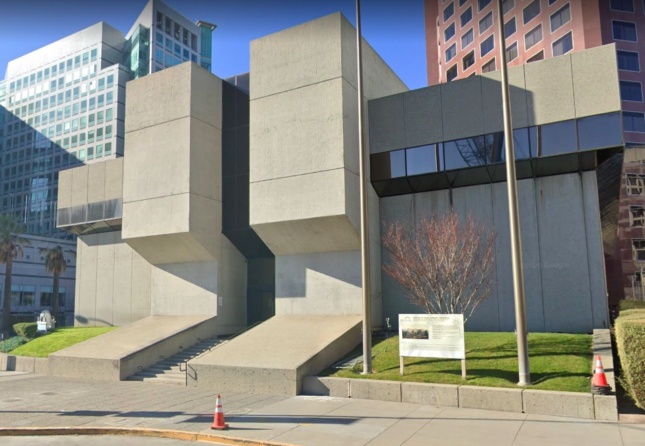Despite the best efforts of the San Jose Historic Landmarks Commission and the city’s Preservation Action Council, César Pelli’s atypically squat Bank of California building—a Brutalist 1973 design produced while the Pritzker Prize-winning Argentine architect was under the employ of Gruen Associates—is not long for this world.
As reported by the Mercury News, the San Jose City Council has given developer the Jay Paul Company the full go-ahead to demolish the hulking concrete building to make way for a trio of interconnected glass office towers that will anchor the new, Gensler-designed CityView Plaza development in downtown San Jose. In addition to the unoccupied Pelli building, which was most recently used as a county courthouse and whose entryway bears a faint resemblance to an abstract sphinx, eight other structures in the immediate area will be demolished. AN first wrote about the plight of the building last month as preservationists rallied to have the old bank at 170 Park Avenue declared a local historic landmark, a designation that wouldn’t have rendered the structure immune from future demolition but would have granted it with an extra layer of protection by putting pressure on local officials to save it.
Those plans didn’t pan out. With the city council’s just-granted consent, Jay Paul Company plans to begin construction on the multi-phase redevelopment scheme later this year after demolition is complete.
Ben Leech, executive director of the Preservation Action Council, made it clear that he isn’t necessarily against CityView Plaza and has argued that the towers can be built without razing the Pelli building, which could potentially be spiffed up and given new life within the tech-centered redevelopment zone. In total, the building encompasses just half-an-acre of the 8.1-acre site, which will ultimately include 3.6 million square feet of office space and 24,000 square feet of retail.
“This is not a vote against CityView Plaza. Its a vote of encouragement to improve the project for the future,” the Mercury News quoted Leech as saying during a council meeting held earlier this week. “This does not have to be an either-or decision.”

Per the San Jose Spotlight, the Jay Paul Company had studied several scenarios in which the bank building was potentially preserved. None, however, were reportedly feasible. In lieu of that, the developer has “offered to make a commemorative virtual reality exhibit of the old plaza and place a plaque on the site where the building stands today,” wrote the Spotlight.
The city’s historic preservation officer, Juliet Arroyo, had previously referred to the building as the “best example” of Brutalist architecture in San Jose, noting that it is “significant because of its quality of design, attention to design detail, materials, and construction method.”
The building’s historic significance, however, has been dismissed by others. This camp includes developer and sports franchise-owner Lew Wolff, who claimed in a letter sent to city officials in March that the structure wasn’t even designed by Pelli, but by an intern. Wolff oversaw the development of Park City Plaza, an early 1970s urban redevelopment scheme that’s footprint will be replaced by CityView Plaza. Pelli’s Bank of America building was the most architecturally prominent feature of Park City Plaza.
As noted by the Spotlight, Wolff explained to city council members that the building “was actually sketched out at a dinner table in my house years and years ago with another architect named Sid Brisker. In my opinion, it’s not an example of any form of architecture, especially (Brutalist) or whatever the term that they assigned to it after they found that César wasn’t the sole architect.”
San Jose Mayor Sam Liccardo sided with the city council on the matter, and wholeheartedly welcomed what he called an “extraordinary investment in our city.”
As he noted before the city council cast its unanimous vote: “We’ve got a lot of ambitions for downtown, particularly for corners like this one, and this architecture is utterly inconsistent with all of our notions of urban design. It also doesn’t take advantage of the very scarce space we have in our very tight, constrained downtown.”











